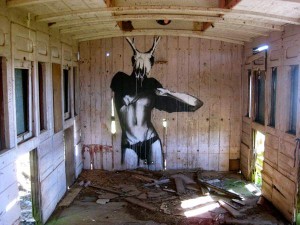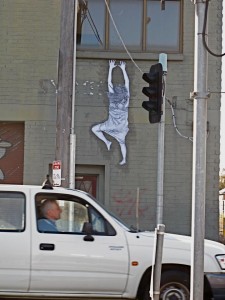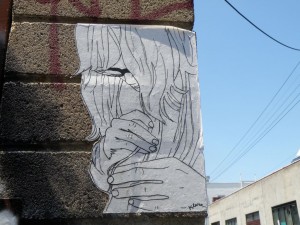women in street art: interview with baby guerrilla, kaff-eine and klara
Street art is often thought of as a dangerous world dominated by men, so I decided to chat to some female Australian street artists to get their perspective. I asked about their influences, what got them started in this scene and what their thoughts are on street art and the law. The sentiment that street artists are presumed male until proven otherwise was one that was expressed by both Kaff-eine and Klara and I wanted to learn more about this world happening on our streets.
I chatted with:
(BG) Baby Guerrilla
(KE) Kaff-eine
(K) Klara
How did you first get into street art?
BG: Street art was a natural progression for me. I was working on small-scale drawings and collage. One day I just went “…what if…?” and started mucking around.
KE: I’ve always been drawing and painting, so the street art is an extension of something I’ve been doing most of my life. I’d stopped drawing for a while, when I stumbled into a really lovely group of mates that included many art-lovers and some street artists. My friends encouraged me to begin making artworks again, and to paste some up or paint them in public. I loved it, it was such a different way for people to interact with my art and for me to interact with the spaces that surrounded me, and so awesome to hang out with likeminded people. It changed the way I related to urban spaces and art.
K: I’ve always loved street art because of its freedom and accessibility. I’ve always created art in some shape or form. I used to tag and détourné as a kid also, but started to take my artwork a bit more seriously in my late teens. I had my first solo show in Melbourne at Off the Kerb Gallery in Collingwood. It wasn’t a huge success. There were a few pieces that didn’t sell… so when it finished I applied the unsold works to the streets instead of storing them in my studio. The creative freedom and feedback I received was much more rewarding what I got in a gallery atmosphere. After that I was hooked, and the process felt more organic, as art should be, without the need for commercial premises or representation. I love every part of the process. The preparation, unpredictability and adventure.
Do you think it’s harder for women street artists to get started?
BG: Females may be more worried about safety concerns if they are working alone at night. Probably depends on the individual. I guess this is an area of concern for females though across all walks of life. The media instils a lot of fear in woman and play up violence. The portrayal of woman in the media isn’t exactly a message of empowerment.
KE: Until recently, I’ve been anonymous in my street work, and most people presumed that I was a guy. This suited me; it meant that I wasn’t readily identifiable, and people didn’t read any particular meaning into (or judge) my artwork based on my sex or gender. I wasn’t interested in having a particular public profile, so it was just a matter of me getting out there and doing what I love. ‘Outing myself’ as a female street artist was a positive move, though, because it gave me the chance to take part in some rad publications and exhibitions. People have been really friendly and generous. It’s been great. I think that if the artist’s work is good quality, original, creative and thoughtful, and they have genuine passion for getting up, they won’t find it hard to get started, regardless of their sex.
K: No, Gender really shouldn’t have much to do with it. I don’t believe so. I’ve never felt any disadvantages because of my gender where street art is concerned. To me, art is art, unbound by gender labels. If you want to do street art or anything for that matter, just get amongst it.
Do you think there is a distinct female quality to your work?
BG: I draw heavily upon not only my experiences as a female in my work, as I am also deeply inspired by the women I have around me including my friends, sisters, nieces and mother. They kick ass as mothers and women in general. The enormous amount of love they carry inside them is embodied in their children. I have drawn and painted them many times and will still be annoying them for many years to come.
KE: No, I’ve never really thought of my art in terms of having male or female qualities. I’m happy about the fact that even now, after being involved in some high-profile ‘female artist’ events; people still regularly presume that I am male.
L: Hmm, no, I don’t think gender should be that important. There are plenty of assumptions on the gender of artists and throughout my life I’ve been questioned as to whether I personally am male or female, so to me it’s irrelevant. I feel I can be either. Whatever or whoever I want to be. It should be about the work, not what’s between the legs.
All the big names in the street art scene that first come to mind are men. Do you think that’s unique to the street art scene or the larger art world?
BG: I think this is rapidly changing. I think the common scale of success is a man made model. I know a lot of woman who have a more nuanced model. Biologically in the man-made model of success woman are at a natural disadvantage time-wise if they take time to raise a family.
KE: I think that public life in general is dominated my men; the street art scene is very public, so it isn’t surprising that many people can recall male street artists, but not so many female ones. However, in the collection of awesome street artists that immediately springs to my mind, there is a mix of people including high-profile female street artists who are truly national and international heavyweights with huge followings. I immediately think of US street artist Swoon’s gorgeous, intricate hand-cut paste-ups and amazing floating installations, and South African Faith 47’s enormous lush murals. Australian female street artists who are known across the globe for their incredible talents include Vexta, with her awesome fluorescent works on walls and animal bones; Miso’s achingly beautiful, gentle street portraits; Deb’s bold colourful women; and Myla’s (part of Dabs Myla) playful, cheeky, bold murals.
K: As a female myself, I always looked up to other female artists such as Swoon, MISO, I & the Others and they’ve always seemed quite apparent to me. Personally, I think this is just the way of the larger world and society. Sports, TV & media, business/corporate, the arts… It’s been a man’s world for a long time and we’ve only just established our rights in the last few decades. It’s a work in progress. Could be for some time. I won’t go any deeper into that, as I feel it’s an argument with many facets and I’d be here all day.
What direction do you want to see Australian street art take?
BG: I would like to see more direct and open opportunities for artists in the public sphere. More collaboration between art and industry. I don’t think Australia utilises its artists enough. So many artists plugging away at menial jobs. I am sure there is a creative model that could be drawn up to make better use of artists’ talents. Perhaps people employed by the government to create opportunities for artists in the public sphere and hooking them up with industry. Art can quite literally colour our world.
KE: The Melbourne street art scene has been incredibly welcoming, friendly and collaborative, and my recent trip to Sydney introduced me to some really generous, warm, welcoming street-art folk. I haven’t been to other Australian capital cities (yet) but I hope that the dynamic I’ve experienced so far continues and expands in future. I wouldn’t mind seeing state law and regulation recognize the increasing profile and influence of graffiti and street art on our tourism and cultural industries for a start, although I’m not sure how that would work in practice. And I hope that we continue to be able to enjoy the brilliant range of awesome murals, pieces, throw ups, tags, paste-ups, installations and other events that we currently have around the country.
K: Opportunity and ease of application or showing for all artists. To lead the rest of the world with our quality of work and placements, without pretence. Less harsh graffiti laws too. I believe Australian street art is in the top five, so we can only go forward and further from here. All while having a fricking amazing time!





Pingback: Recent interviews « kaffeinestreetartist
Pingback: BEFORE i FORGET » 366 PICTURES – THE UNSEEN – DAY 4 written by Simon Jones